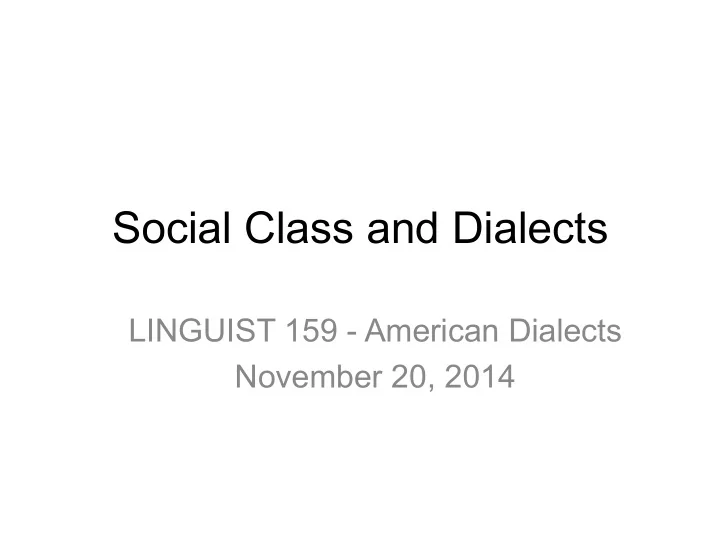

Social Class and Dialects LINGUIST 159 - American Dialects November 20, 2014
Social ¡Stra*fica*on ¡of ¡English ¡in ¡NYC ¡ (Labov ¡1966) ¡ ¡
Social ¡Stra*fica*on ¡of ¡English ¡in ¡NYC ¡ (Labov ¡1966) ¡ ¡ Labov’s ¡general ¡hypothesis ¡was ¡that ¡variables ¡ would ¡show ¡class ¡stra*fica*on. ¡ ¡ 1) word-‑final ¡and ¡pre-‑consonantal ¡/r/ ¡ 2) BAT-‑height ¡(short ¡/a/ ¡system) ¡ 3) BOUGHT ¡– ¡height ¡ 4) (th) ¡(stopping) ¡ 5) (dh) ¡(stopping) ¡ 6) (ING) ¡(fron*ng) ¡ 7) BOW ¡frontness ¡ 8) BIDE ¡backness ¡
Stable ¡Variables ¡and ¡Class ¡
Unstable ¡Variables ¡and ¡Class ¡ Change ¡from ¡above ¡ ¡
Unstable ¡Variables ¡and ¡Class ¡ Change ¡from ¡above: ¡ Above the level of consciousness (also tends to originate in upper classes and moves downward) ¡ ¡
Unstable ¡Variables ¡and ¡Class ¡ Change ¡from ¡below ¡ ¡
Sound ¡changes ¡led ¡by ¡the ¡LMC? ¡ Does ¡this ¡make ¡sense? ¡ ¡ ¡ Poten*al ¡counterexamples? ¡
Unstable ¡Variables ¡and ¡Class ¡ Change ¡from ¡above: ¡ Above the level of consciousness (tends to originate in upper classes and moves downward) Change ¡from ¡below: ¡ Below the level of consciousness (tends to originate in lower classes and moves outward) ¡
Wolfram ¡1969 ¡ AAVE ¡in ¡Detroit ¡ ¡ (composite ¡index ¡included ¡ residency ) ¡ ¡ Consonant ¡cluster ¡reduc*on ¡(CCR) ¡ (dh)-‑stopping ¡ (d) ¡– ¡word-‑final ¡devoicing/dele*on ¡ (r) ¡
Wolfram ¡1969 ¡ Varia*on-‑wise, ¡class ¡differences ¡are ¡ quan,ta,ve ¡ rather ¡than ¡ qualita,ve . ¡ ¡ i.e., ¡middle-‑class ¡and ¡working-‑class ¡dialects ¡ differ ¡chiefly ¡in ¡their ¡ frequencies ¡of ¡non-‑ standard ¡linguis*c ¡forms, ¡rather ¡than ¡in ¡the ¡ presence/absence ¡of ¡these ¡forms. ¡
Is ¡this ¡evidence ¡for ¡a ¡ ¡ pres%ge ¡model ¡ of ¡class-‑based ¡varia*on? ¡
Pres*ge ¡and ¡language ¡varia*on ¡ “One ¡can’t ¡avoid ¡the ¡implica*on ¡that ¡in ¡New ¡ York ¡City ¡we ¡must ¡have ¡an ¡equal ¡and ¡opposing ¡ pres*ge ¡for ¡informal, ¡working-‑class ¡speech ¡– ¡a ¡ covert ¡pres,ge ¡enforcing ¡the ¡speech ¡paeern. ¡ We ¡must ¡assume ¡that ¡people ¡in ¡New ¡York ¡City ¡ want ¡to ¡talk ¡as ¡they ¡do, ¡yet ¡this ¡fact ¡is ¡not ¡at ¡all ¡ obvious ¡in ¡any ¡overt ¡response ¡that ¡you ¡can ¡draw ¡ from ¡interview ¡subjects.” ¡(Labov ¡1966, ¡p. ¡108) ¡
Types of Prestige (Eckert 1989) Overt (Global) Prestige: forms that have widespread recognition of positive social significance. Based on norms imposed by the standard language marketplace. Covert Prestige: forms that are positively valued apart from, or even in opposition to, their social significance for the wider society. Opposed to standard language norms. Local Prestige: forms that have local recognition of positive social significance. Based on locally-imposed norms, orthogonal to the standard language marketplace.
Consensus ¡vs. ¡Conflict ¡models ¡ “…instead ¡of ¡posi*ng ¡a ¡sociolinguis*c ¡ con*nuum ¡with ¡a ¡local ¡vernacular ¡at ¡the ¡boeom ¡ and ¡a ¡pres*ge ¡dialect ¡at ¡the ¡top, ¡with ¡linguis*c ¡ movement ¡of ¡individuals ¡in ¡a ¡generally ¡upward ¡ direc*on, ¡we ¡may ¡view ¡the ¡vernacular ¡as ¡a ¡ posi*ve ¡force: ¡it ¡may ¡be ¡in ¡direct ¡conflict ¡with ¡ standardized ¡norms, ¡u*lized ¡as ¡a ¡symbol ¡by ¡ speakers ¡to ¡carry ¡powerful ¡social ¡meanings ¡and ¡ so ¡resistant ¡to ¡external ¡pressures.” ¡(Milroy ¡ 1980, ¡p. ¡19) ¡
What ¡has ¡incorpora*ng ¡social ¡class ¡ gained ¡us ¡in ¡the ¡study ¡of ¡dialect ¡ varia*on? ¡ (so ¡far) ¡
Slide ¡on ¡networks? ¡ Quickly ¡ ¡-‑ ¡milroy ¡ Dodsworth ¡and ¡Prichard ¡
Acker ¡ Response ¡– ¡how ¡a ¡community ¡of ¡prac*ce ¡ approach ¡can ¡illuminate ¡this ¡ ¡ Amer ¡which ¡discuss ¡Mallinson ¡and ¡Childs. ¡
Acker ¡(2006) ¡ 1. Social ¡rela*ons ¡and ¡structures ¡are ¡ac*ve ¡ prac*ces, ¡occurring ¡in ¡specific ¡historical ¡and ¡ geographic ¡places. ¡ 2. White ¡male ¡class ¡actors ¡are ¡not ¡the ¡only ¡ representa*ves ¡of ¡class ¡structure. ¡ 3. Class ¡is ¡inextricably ¡linked ¡with ¡gender ¡and ¡ race. ¡ 4. Economic ¡rela*ons ¡that ¡cons*tute ¡class ¡go ¡ beyond ¡produc*on. ¡( symbolic ¡capital , ¡ Bourdieu) ¡
Mallinson ¡2007 ¡ “Thus, Acker may provide for sociolinguists a theoretically and analytically strong, integrationist and intersectional, relational framework to social class. It incorporates individual and group attitudes, values, lifestyles, and cultures, while centering on how the development of these subjectivities are an outgrowth of differential relationships to economic resources that determine life chances (in ways that also relate to gender, race, etc.).” (p. 155) ¡
Mallinson ¡and ¡Childs ¡(2007) ¡ • What ¡is ¡the ¡research ¡ques*on? ¡ ¡ • Where ¡was ¡the ¡research ¡conducted? ¡ ¡ • Who ¡were ¡the ¡speakers? ¡ ¡ • How ¡was ¡data ¡elicited? ¡ ¡ • Why ¡were ¡these ¡methods ¡chosen? ¡ ¡ • Which ¡variable ¡(or ¡variables) ¡is ¡inves*gated? ¡ ¡ • What ¡were ¡the ¡findings? ¡ ¡
Mallinson ¡and ¡Childs ¡(2007) ¡ Community ¡of ¡prac*ce ¡(Lave ¡and ¡Wenger ¡1991; ¡ Wenger ¡1998): ¡ ¡ 1) mutual ¡engagement ¡of ¡members ¡ 2) a ¡jointly ¡nego*ated ¡enterprise ¡ 3) shared ¡repertoire ¡ ¡
Mallinson ¡and ¡Childs ¡(2007) ¡ CL: AE norms PS: AAE norms CL: AAE norms (less) PS: AAE norms CL: use it (much less) PS: use it (much more) Both use it (no CofP difference) Both do not use it (no CofP difference)
Mallinson ¡and ¡Childs ¡(2007) ¡
Mallinson ¡ ¡ and ¡Childs ¡ (2007) ¡
What ¡has ¡incorpora*ng ¡social ¡class ¡ gained ¡us ¡in ¡the ¡study ¡of ¡dialect ¡ varia*on? ¡
Recommend
More recommend